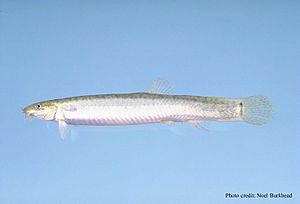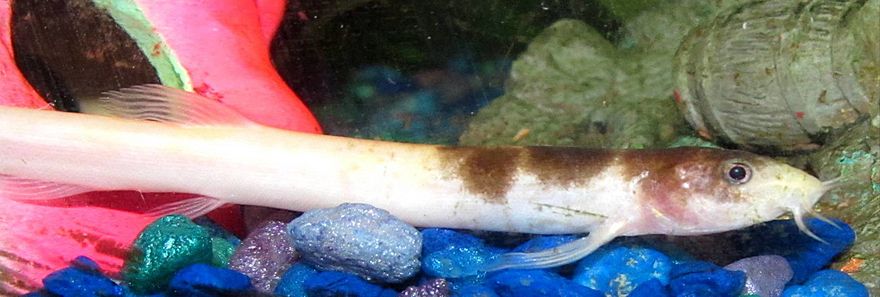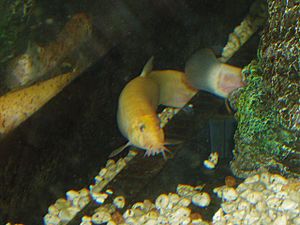Pond loach facts for kids
Quick facts for kids Pond loach |
|
|---|---|
 |
|
| Conservation status | |
| Scientific classification | |
| Synonyms | |
|
The pond loach (Misgurnus anguillicaudatus) is a type of freshwater fish. It belongs to the loach family, called Cobitidae. These fish originally come from East Asia.
Pond loaches are also popular as aquarium fish. They have been introduced to other parts of Asia, Europe, America, and Australia. Another common name for them is weather loach. This name is also used for other loaches. They are called "weather loaches" because they can sense changes in air pressure. Before a storm, the air pressure changes, and this makes these fish swim around a lot. Pond loaches come in many colors, like pink, orange, albino, and gray.
Contents
About the Pond Loach
Like many other loaches, pond loaches have long, thin bodies. They look a bit like eels or snakes. Their color can be yellow, olive green, light brown, or gray. Their bellies are usually lighter.
The pond loach has three sets of whiskers, called barbels, around its mouth. It uses these barbels to search for food in mud or small stones. They also use them to dig under gravel or sand to hide. Other loaches use spines under their eyes for defense.
Pond loaches can grow up to 12 inches (30 cm) long in the wild. But in an aquarium, they usually only reach about 6 inches (15 cm). These fish live at the bottom of the water. They mostly eat dead plant and animal material like algae. Pond loaches are omnivores, meaning they eat both plants and animals. They might also eat tubifex worms and other tiny water creatures.
Pond loaches are very tough fish. They can live in water that is not very clean. They can even survive for short times out of water. They do this by making a layer of slime on their bodies to stay wet.
How Pond Loaches Survive
Unlike most fish, pond loaches can dig into soft mud or sand. They can also breathe air from the atmosphere if they need to. This helps them survive for long periods outside of water.
To live on land, pond loaches have special body features. These features help them control harmful substances like ammonia in their bodies. They can stop their bodies from making too much ammonia. They can also change ammonia into less harmful things. Sometimes, they can even get rid of ammonia by breathing it out as a gas.
Pond loaches are also not very sensitive to ammonia. This means their bodies can work even with ammonia levels that would kill other fish. Scientists are still studying how their brains and hearts can do this.
Pond Loaches in Aquariums
Pond loaches are active, calm, and strong fish. They are sometimes used as good fish for beginners in aquariums. They can even be "friendly" with people. They might let you touch them or feed them by hand. They get along well with goldfish.
These loaches are more active if they have more space and are kept in groups. A single pond loach might spend a lot of time hiding. They need places to hide, like decorations they can swim through or driftwood.
Pond loaches are good at jumping. So, make sure your aquarium cover is secure. They might even swim up tubes and hide in filters! Always check there if your loach seems to disappear.
Pond loaches love to dig and bury themselves in the bottom of their tank. Make sure the gravel or sand is fine enough for them to dig in. If you have live plants, the loaches might dig them up. It's a good idea to weigh your plants down. Sometimes, when they are stressed, pond loaches will bury themselves completely. New owners might be surprised when their fish "disappears" and then "reappears" later.
Pond loaches like to eat snails. They can help if you have too many snails in your tank. However, many people say they don't eat snails fast enough to clear a big snail problem.
These fish prefer water with a pH of 6.5 to 8.0. But they can handle much more acidic water for a long time without problems. This makes them a great choice for new aquariums. They are hardy fish that can handle a few mistakes.
Pond loaches should be kept in groups of at least three. They like to be close to each other. They often touch each other with their barbels when they rest.
They can survive in very cold or very warm water. But they do best when the water temperature is between 68 and 72 degrees Fahrenheit (15 to 25 degrees Celsius). Even though they can adapt, the water temperature should not change a lot during the day. Big changes can stress them out.
There are also special types of pond loaches bred in captivity. These include the gold strain and the peppered strain. Sometimes, the pond loach (especially the golden type) is confused with the kuhli loach. However, kuhli loaches like warmer water. They also prefer more acidic conditions. And they grow much smaller, only about 4 inches (10 cm) long.
Pond Loaches as Food
The pond loach is a common fish eaten in East Asia. It is raised in large numbers on fish farms. In 2018, the pond loach was the 30th most important species in fish farming worldwide. This was based on the total weight of fish produced.
In Korea, a soup called chueo-tang (loach soup) is made with pond loach.
Where Pond Loaches Live
Native Home
Pond loaches are originally from eastern Asia. This area stretches from Siberia to Northern Vietnam, and includes Japan.
New Homes Around the World
Between 2010 and 2020, pond loaches were found in 10 states in the United States. These states include Alabama and Georgia. In November 2020, they were found in McNutt creek in Athens. This shows that eastern Georgia is a good environment for them. If they are not stopped, pond loaches are expected to spread throughout this area. This could include rivers like the Oconee River, the Ocmulgee River, and the Altamaha River.
As of November 2021, pond loaches have also been caught in the wild in many other U.S. states. These include Illinois (especially around Chicago), New York, Ohio, Michigan, Washington, Oregon, Maryland, New Jersey, North Carolina, Louisiana, and southern California.
Images for kids
See also
 In Spanish: Dojo para niños
In Spanish: Dojo para niños






